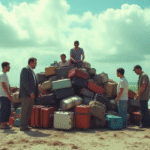Introduction
Guillermo Arriaga, a renowned Mexican writer and filmmaker, delves into the complex relationship between barbarism and civilization in his latest novel, “The Man.” The book, published in Mexico this week, examines the foundational sins of the United States – slavery, genocide of Native Americans, and the Mexican territory’s dispossession – to uncover the blood-soaked roots of great fortunes and empires.
Guillermo Arriaga: A Prominent Mexican Author
Arriaga is one of the most read Mexican authors today. His novel “The Man” sold out within the first two days of its pre-release in Mexico. His most successful work to date is “Save the Fire,” which won the Alfaguara Novel Prize in 2020. Other acclaimed works include “The Wild,” “Night Buffalo” (1999), and “Guillotine Squad” (1991).
Barbarism and Civilization: A Direct Link
Arriaga asserts that “barbarism is directly linked to civilization. We are closer to barbarism than we think,” he says. “Sometimes, it only takes looking at a historical moment for brutality to reveal itself in all its ferocity.”
Historical Racial Relations: From Slavery to Mestizaje
In “The Man,” Arriaga also focuses on the historical relationship between races, from slavery to mestizaje and its tension with the barbarism that wielded the banner of civilization.
Arriaga’s Personal Connection to the Subject
As a bow hunter, Arriaga spends his time in the mountains of northern Mexico, carrying only an arrow and bow. He views hunting as a ritual rather than a sport and criticizes those who pursue trophies alone. His frequent trips to the border, particularly to ranches along the Rio Grande, have given him a profound understanding of the distinct civilizations on either side.
The Construction of the United States: A Rapid Rise
Arriaga is intrigued by how the United States, a powerful nation, was built in such a short time. He questions what was done to transform a small country into a continental power within 80 years, with a GDP comparable to all of Europe.
Migration and Labor: A Shared History
The construction of Mexico and the United States is based on shared or appropriated resources, a history that extends beyond these nations to their indigenous origins. The political and economic relationship between the two countries remains intertwined, particularly through labor.
The Current US Government’s Stance on Mexican Labor
Arriaga hints at a late-novel reflection on the use of migration, stating that large capital benefits from it. He notes that major capitals resist restrictions on migration, as cheap labor benefits capitalism.
“The Man”: Book Details
- Guillermo Arriaga
- Publication Date: 2025
- Publisher: Alfaguara
- Pages: 679
- Hardcover: MXN 549
- Digital: MXN 329
A Novel Excerpt
“Yes, we kill, burn, and leave unjustified remains, but in the end, progress rises from the ruins, seated on a throne of blood.”
Key Questions and Answers
- What is Guillermo Arriaga’s latest novel about? “The Man” explores the dark side of progress in the United States, focusing on slavery, genocide, and territorial dispossession.
- Why is Arriaga’s work significant? His unique perspective on life and his refusal to repeat himself make his literary works distinct, yet interconnected.
- What is Arriaga’s view on the relationship between Mexico and the United States? Their histories are intertwined through shared resources and labor, with the current US government’s stance on Mexican labor being a point of contention.






